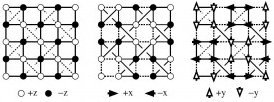
Roderich Moessner
Publications
A list of almost all of my publications in preprint form is available on the arXiv and a PDF list:
The following pieces of work give a short overview of the central results over the years:
Resonating Valence Bond Phase in the Triangular Lattice Quantum Dimer Model
We study the quantum dimer model on the triangular lattice, which is expected to describe the singlet dynamics of frustrated Heisenberg models in phases where valence bond configurations dominate their physics. We find, in contrast to the square lattice, that there is a truly short ranged resonating valence bond (RVB) phase with no gapless collective excitations and with deconfined, gapped, spinons for a finite range of parameters. We also establish the presence of three crystalline phases in this system.
R. Moessner and S. L. Sondhi, Phys. Rev. Lett. 86, 1881 (2001) ; arXiv.pdf
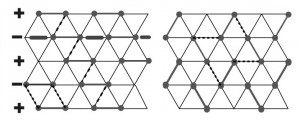
Magnetic Monopoles in Spin ice
Electrically charged particles, such as the electron, are ubiquitous. By contrast, no elementary particles with a net magnetic charge have ever been observed, despite intensive and prolonged searches. We pursue an alternative strategy, namely that of realising them not as elementary but rather as emergent particles, i.e., as manifestations of the correlations present in a strongly interacting many-body system. The most prominent examples of emergent quasiparticles are the ones with fractional electric charge e/3 in quantum Hall physics. Here we show that magnetic monopoles do emerge in a class of exotic magnets known collectively as spin ice: the dipole moment of the underlying electronic degrees of freedom fractionalises into monopoles. This enables us to account for a mysterious phase transition observed experimentally in spin ice in a magnetic field, which is a liquid-gas transition of the magnetic monopoles. These monopoles can also be detected by other means, e.g., in an experiment modelled after the celebrated Stanford magnetic monopole search.
C. Castelnovo, R. Moessner and S. L. Sondhi, Nature 451, 42 (2008) ; arXiv.pdf
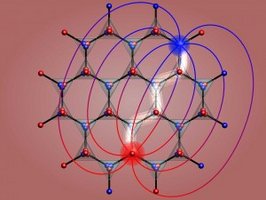
Dirac Strings and Magnetic Monopoles in Spin Ice Dy2Ti2O7
While sources of magnetic fields - magnetic monopoles - have so far proven elusive as elementary particles, several scenarios have been proposed recently in condensed matter physics of emergent quasiparticles resembling monopoles. A particularly simple proposition pertains to spin ice on the highly frustrated pyrochlore lattice. The spin ice state is argued to be well-described by networks of aligned dipoles resembling solenoidal tubes - classical, and observable, versions of a Dirac string. Where these tubes end, the resulting defect looks like a magnetic monopole. We demonstrate, by diffuse neutron scattering, the presence of such strings in the spin-ice Dy2Ti2O7. This is achieved by applying a symmetry-breaking magnetic field with which we can manipulate density and orientation of the strings. In turn, heat capacity is described by a gas of magnetic monopoles interacting via a magnetic Coulomb interaction.
D. J. P. Morris, D. A. Tennant, S. A. Grigera, B. Klemke, C. Castelnovo, R. Moessner, C. Czternasty, M. Meissner, K. C. Rule, J.-U. Hoffmann, K. Kiefer, S. Gerischer, D. Slobinsky and R. S. Perry, Science 326, 411 (2009) ; arXiv.pdf
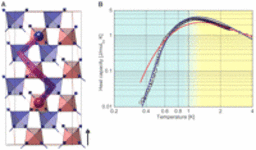
Spin Ice, Fractionalization and Topological Order
The spin ice compounds Dy2Ti2O7 and Ho2Ti2O7 are highly unusual magnets which epitomize a set of concepts of great interest in modern condensed matter physics: their low-energy physics exhibits an emergent gauge field and their excitations are magnetic monopoles which arise from the fractionalization of the microscopic magnetic spin degrees of freedom. In this review, we provide an elementary introduction to these concepts and we survey the thermodynamics, statics and dynamics - in and out of equilibrium - of spin ice from these vantage points. Along the way, we touch on topics such as emergent Coulomb plasmas, observable "Dirac strings", and irrational charges. We close with the outlook for these unique materials.
C. Castelnovo, R. Moessner and S. L. Sondhi, Annu. Rev. Condens. Matter Phys. 3, 35 (2012) ; arXiv.pdf
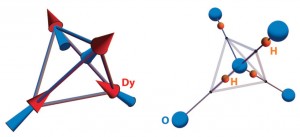
Low-temperature properties of classical, geometrically frustrated antiferromagnets
We study the ground-state and low-energy properties of classical vector spin models with nearest-neighbour antiferromagnetic interactions on a class of geometrically frustrated lattices which includes the kagome and pyrochlore lattices. We explore the behaviour of these magnets that results from their large ground-state degeneracies, emphasising universal features and systematic differences between individual models. We investigate the circumstances under which thermal fluctuations select a particular subset of the ground states, and find that this happens only for the models with the smallest ground-state degeneracies. For the pyrochlore magnets, we give an explicit construction of all ground states, and show that they are not separated by internal energy barriers. We study the precessional spin dynamics of the Heisenberg pyrochlore antiferromagnet. There is no freezing transition or selection of preferred states. Instead, the relaxation time at low temperature, T, is of order hbar/(kB T). We argue that this behaviour can also be expected in some other systems, including the Heisenberg model for the compound SrCr8Ga4O19.
R. Moessner and J. T. Chalker, Phys. Rev. B 58, 12049 (1998) ; arXiv.pdf
Properties of a classical spin liquid: the Heisenberg pyrochlore antiferromagnet
We study the low-temperature behaviour of the classical Heisenberg antiferromagnet with nearest neighbour interactions on the pyrochlore lattice. Because of geometrical frustration, the ground state of this model has an extensive number of degrees of freedom. We show, by analysing the effects of small fluctuations around the ground-state manifold, and from the results of Monte Carlo and molecular dynamics simulations, that the system is disordered at all temperatures, T, and has a finite relaxation time, which varies as 1/T for small T.
R. Moessner and J. T. Chalker, Phys. Rev. Lett. 80, 2929 (1998) ; arXiv.pdf
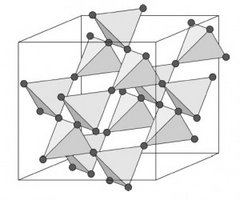
Exact results for interacting electrons in high Landau levels
We study a two-dimensional electron system in a magnetic field with a fermion hardcore interaction and without disorder. Projecting the Hamiltonian onto the n-th Landau level, we show that the Hartree-Fock theory is exact in the limit n ➝ ∞ , for the high temperature, uniform density phase of an infinite system; for a finite-size system, it is exact at all temperatures. In addition, we show that a charge-density wave arises below a transition temperature T_t. Using Landau theory, we construct a phase diagram which contains both unidirectional and triangular charge-density wave phases. We discuss the unidirectional charge-density wave at zero temperature and argue that quantum fluctuations are unimportant in the large-n limit. Finally, we discuss the accuracy of the Hartree-Fock approximation for potentials with a nonzero range such as the Coulomb interaction.
R. Moessner and J. T. Chalker, Phys. Rev. B 54, 5006 (1996); arXiv.pdf
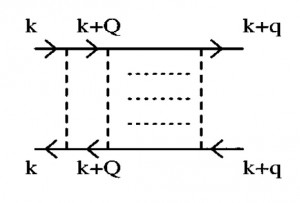
Dynamics of a two-dimensional quantum spin liquid: signatures of emergent Majorana fermions and fluxes
Topological states of matter present a wide variety of striking new phenomena. Prominent among these is the fractionalisation of electrons into unusual particles: Majorana fermions [1], Laughlin quasiparticles [2] or magnetic monopoles [3]. Their detection, however, is fundamentally complicated by the lack of any local order, such as, for example, the magnetisation in a ferromagnet. While there are now several instances of candidate topological spin liquids [4], their identification remains challenging [5]. Here, we provide a complete and exact theoretical study of the dynamical structure factor of a two-dimensional quantum spin liquid in gapless and gapped phases. We show that there are direct signatures - qualitative and quantitative - of the Majorana fermions and gauge fluxes emerging in Kitaev's honeycomb model. These include counterintuitive manifestations of quantum number fractionalisation, such as a neutron scattering response with a gap even in the presence of gapless excitations, and a sharp component despite the fractionalisation of electron spin. Our analysis identifies new varieties of the venerable X-ray edge problem and explores connections to the physics of quantum quenches.
J. Knolle, D. L. Kovrizhin, J. T. Chalker and R. Moessner; Phys. Rev. Lett. 112, 207203 (2014); arXiv.pdf
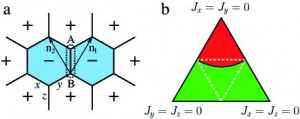
Coulomb and Liquid Dimer Models in Three Dimensions
We study classical hard-core dimer models on three-dimensional lattices using analytical approaches and Monte Carlo simulations. On the bipartite cubic lattice, a local gauge field generalization of the height representation used on the square lattice predicts that the dimers are in a critical Coulomb phase with algebraic, dipolar, correlations, in excellent agreement with our large-scale Monte Carlo simulations. The non-bipartite FCC and Fisher lattices lack such a representation, and we find that these models have both confined and exponentially deconfined but no critical phases. We conjecture that extended critical phases are realized only on bipartite lattices, even in higher dimensions.
D. A. Huse, W. Krauth, R. Moessner and S. L. Sondhi, Phys. Rev. Lett. 91, 167004 (2003) ; arXiv.pdf
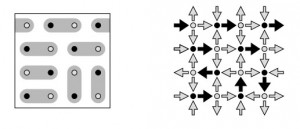
Three dimensional resonating valence bond liquids and their excitations
We show that there are two types of RVB liquid phases present in three-dimensional quantum dimer models, corresponding to the deconfining phases of U(1) and Z2 gauge theories in d=3+1. The former is found on the bipartite cubic lattice and is the generalization of the critical point in the square lattice quantum dimer model found originally by Rokhsar and Kivelson. The latter exists on the non-bipartite face-centred cubic lattice and generalizes the RVB phase found earlier by us on the triangular lattice. We discuss the excitation spectrum and the nature of the ordering in both cases. Both phases exhibit gapped spinons. In the U(1) case we find a collective, linearly dispersing, transverse excitation, which is the photon of the low energy Maxwell Lagrangian and we identify the ordering as quantum order in Wen's sense. In the Z2 case all collective excitations are gapped and, as in d=2, the low energy description of this topologically ordered state is the purely topological BF action. As a byproduct of this analysis, we unearth a further gapless excitation, the pi0n, in the square lattice quantum dimer model at its critical point.
R. Moessner and S. L. Sondhi, Phys. Rev. B 68, 184512 (2003) ; arXiv.pdf
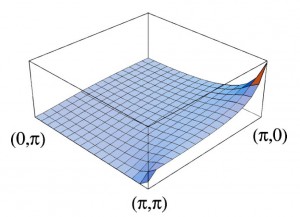
Artificial square ice and related dipolar nanoarrays
We study a frustrated dipolar array recently manufactured lithographically by Wang et al. [Nature 439, 303 (2006)] in order to realize the square ice model in an artificial structure. We discuss models for thermodynamics and dynamics of this system. We show that an ice regime can be stabilized by small changes in the array geometry; a different magnetic state, kagome ice, can similarly be constructed. At low temperatures, the square ice regime is terminated by a thermodynamic ordering transition, which can be chosen to be ferro- or antiferromagnetic. We show that the arrays do not fully equilibrate experimentally, and identify a likely dynamical bottleneck.
G. Moller and R. Moessner, Phys. Rev. Lett. 96, 237202 (2006); arXiv.pdf
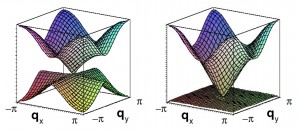
Magnetic multipole analysis of kagome and artificial ice dipolar arrays
We analyse an array of linearly extended monodomain dipoles forming square and kagome lattices. We find that its phase diagram contains two (distinct) finite-entropy kagome ice regimes - one disordered, one algebraic - as well as a low-temperature ordered phase. In the limit of the islands almost touching, we find a staircase of corresponding entropy plateaux, which is analytically captured by a theory based on magnetic charges. For the case of a modified square ice array, we show that the charges ('monopoles') are excitations experiencing two distinct Coulomb interactions: a magnetic 'three-dimensional' one as well as a logarithmic `two dimensional' one of entropic origin.
G. Moller and R. Moessner, Phys. Rev. B 80, 140409 (2009); arXiv.pdf
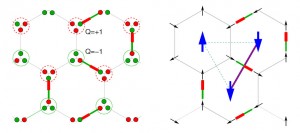
Quantum order by disorder and accidental soft mode Er2Ti2O7
Motivated by recent neutron scattering experiments, we derive and study an effective "pseudo-dipolar" spin-1/2 model for the XY pyrochlore antiferromagnet Er2Ti2O7. While a bond-dependent in-plane exchange anisotropy removes any continuous symmetry, it does lead to a one-parameter `accidental' classical degeneracy. This degeneracy is lifted by quantum fluctuations in favor of the non-coplanar spin structure observed experimentally - a rare experimental instance of quantum order by disorder. A non-Goldstone low-energy mode is present in the excitation spectrum in accordance with inelastic neutron scattering data. Our theory also resolves the puzzle of the experimentally observed continuous ordering transition, absent from previous models.
M. E. Zhitomirsky, M. V. Gvozdikova, P. C. W. Holdsworth and R. Moessner, Phys. Rev. Lett. 109, 077204 (2012) ; arXiv.pdf
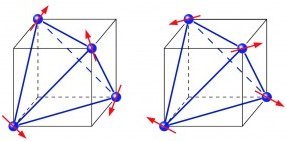
Order by disorder and string modes in pyrochlore antiferromagnet
We study the effects of magnetoelastic couplings on pyrochlore antiferromagnets. We employ Landau theory, extending an investigation begun by Yamashita and Ueda for the case of S=1, and semiclassical analyses to argue that such couplings generate bond order via a spin-Peierls transition. This is followed by, or concurrent with, a transition into one of several possible low-temperature Neel phases, with most simply collinear, but also coplanar or mixed spin patterns. In a collinear Neel phase, a dispersionless string-like magnon mode dominates the resulting excitation spectrum, providing a distinctive signature of the parent geometrically frustrated state. We comment on the experimental situation.
O. Tchernyshyov, R. Moessner and S. L. Sondhi, Phys. Rev. Lett. 88, 067203 (2002) ; arXiv.pdf
